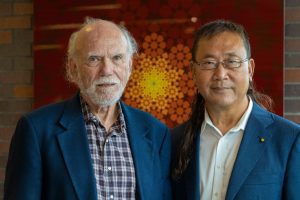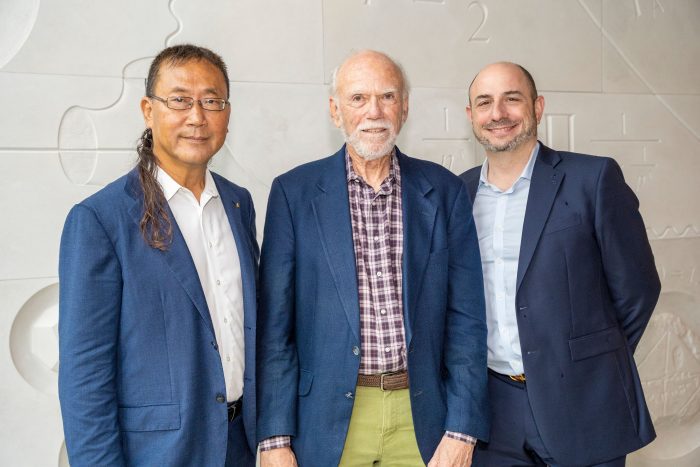By Daniel Dunaief
Albert Einstein predicted gravitational waves existed, but figured interference on the Earth would make them impossible to observe. He was right on the first count. On the second, it took close to a century to create an instrument capable of detecting gravitational waves. The first confirmed detection, which was generated 1.3 billion light years away when two black holes collided, occurred in September of 2015.
For his pioneering work with gravitational waves, which now include numerous other such observations, Barry Barish shared the Nobel Prize in 2017 with physicists Rainer Weiss and Kip Thorne.
In the fall of 2023, Barish is bringing his physics background and knowledge to Stony Brook University, where he will be the inaugural President’s Distinguished Endowed Chair in Physics. Barish will teach graduate students and serve as an advisor to Chang Kee Jung, Chair of the Department of Physics and Astronomy and Distinguished Professor.

“I’m really happy,” said Jung in an interview. “Nobel Prize winning work is not all the same. This work [Barish] has done with LIGO [the Laser Interferometer Gravitational-Wave Observatory] is incredible.”
Jung suggested the discovery of these two merging black holes “opened up a completely new field of astronomy using gravitational waves.” The finding is a “once-in-a-generation discovery.”
Gravitational waves disrupt the fabric of spacetime, a four-dimensional concept Einstein envisioned that combines the three dimensions of space with time. These waves are created when a neutron star with an imperfect spherical shape spins, and during the merger of two black holes, the merger of two neutron stars, or the merger of a neutron star and a black hole.
Jung suggested a way to picture a gravitational wave. “Imagine you have a bathtub with a little rubber ducky,” he said. In the corner of the bathtub, “you slam your hand into the water” which will create a ripple that will move the duck. In the case of the gravitational wave Barish helped detect, two black holes slamming into each other over 1.2 billion light years ago, when life on Earth was transitioning from single celled to multi celled organisms, started that ripple.
While Barish, 86, retired after a lengthy and distinguished career at CalTech in 2005, Stony Brook has no plans to create a team of physicists who specialize in this area. “The most important thing is that people together exchange ideas and figure out what to do next that’s interesting,” Barish said in an interview. “I’ll keep doing gravitational waves.”
Instead of encouraging graduate students and even undergraduates to follow in his footsteps, Barish hopes to “help stimulate the future here and help educate students,” he said.
An important call
Jung, who became chair of the department in the fall of 2021, has known Barish for over three decades. On a periodic informal zoom call, Jung reached out to Barish to tell him Stony Brook had offered Jung the opportunity to become chair. Barish suggested he turn it down. As Jung recalled, Barish said, “Why do you want to do that?”
On another informal call later on, Jung told Barish he decided to become chair, explaining that he wanted to serve the university and the department. Barish asked him what he would do as chair. Jung replied, “‘I would like guys like you to come to Stony Brook. It took [Barish] about 10 seconds to think about it and then he said, ‘That’s possible.’”
That, Jung said, is how a Nobel Prize winning scientist took the first steps towards joining Stony Brook.
Last week, Barish came to Stony Brook to deliver an inaugural lecture as a part of the newly created C.N. Yang Colloquium series in the Department of Physics and Astronomy.
Stony Brook officials were thrilled with Barish’s appointment and the opportunity to learn from his well-attended on-site lecture.
In remarks before Barish’s packed talk at the Simons Center Della Pietra Family Auditorium, Carl Lejuez, Executive Vice President and Provost, said he hears the name C.N. Yang “all the time,” which reflects Yang’s foundational contribution to Stony Brook University. “It’s fitting that we honor his legacy with a speaker of Dr. Barish’s character who, like Yang, is also a Nobel Prize winner. It’s a really nice synergy.”
Indeed, Yang, who won his Nobel Prize in 1957, coming to Stony Brook “instantaneously raised the university profile,” said Jung, whose department is the largest on campus with 75 faculty.
Surrounded by a dedicated team of scientists, and with the addition of another Nobel Prize winner to the fold, Jung believes the team will continue to thrive.
“If you put together great minds, great things will happen,” he said.
Seeing the bigger picture
Barish is eager to encourage undergraduates and graduate students to consider the bigger picture in the realm of physics.
“[In general] we train graduate students to do something really important by making them narrower and narrower and narrower, so they can concentrate on doing something that’s worthy of getting a thesis and is as important as possible,” Barish said. “That works against creating a scientist who can look beyond something narrow. That’s bothered me for a long time.”
The problem, Barish continued, is that once researchers earn their degree, they continue on the same path. “Why should you happen to have had a supervisor in graduate school determine what you do for the rest of your life?” he asked.
Once students have the tools of physics, whether they are experimental or theoretical, they shouldn’t be so locked in, he urged. “It’s possible to use these same tools to do almost any problem in physics,” Barish added.
His goal in a course he plans to teach to advanced graduate students (that’s also open to undergraduates) is to provide exposure to the frontiers of science.
A few years ago, Barish recalled how the New York Times ran a picture of a black hole above the fold. He taught a class how scientists from around the world combined radio telescopes to make it act like one radio telescope the size of the Earth.
Helping students understand how that happened “pays off in the long run in making our physics students that we turn out be broader and more interesting and more interested in physics,” Barish said.
When Barish arrives next September, Jung said he plans to have some assignments for interactions with undergraduates. “Undergraduate research is critically important,” Jung said. Barish will also interact with various student groups, as well as the community outside the university.
“We will create those opportunities,” Jung said.





